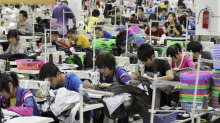World Bank trims China's growth outlook
 The World Bank cut its growth forecast for China on Thursday, adding to warnings the world’s second-largest economy might slow too abruptly, and said Beijing should be ready to launch a new stimulus if needed.
The World Bank cut its growth forecast for China on Thursday, adding to warnings the world’s second-largest economy might slow too abruptly, and said Beijing should be ready to launch a new stimulus if needed.The bank stressed it expects a “soft landing” but trimmed its growth outlook this year to a still-robust 8.2 per cent from 8.4 per cent. It cited U.S. and European economic woes and Chinese lending and investment curbs imposed to cool an overheated economy.
Beijing is trying to steer growth that spiked to 10.4 per cent in 2010 to a sustainable level without causing the economy to stall. Some analysts say it is succeeding, but others say government controls, coupled with last year’s plunge in export demand, might cause growth to nosedive, raising the risk of job losses and unrest.
“While the prospects for a soft landing remain high, there are concerns that growth slows too quickly,” the bank said in a quarterly report on China.
The Washington-based bank, which acts as a consultant to governments and lends to finance anti-poverty programs, said that if the downturn worsens, Beijing should be ready to cut taxes and step up social spending to shore up growth.
In a “very volatile environment” the government needs “to be very flexible and to really look at the data as they come in month by month and be ready to move,” the bank’s lead China economist, Ardo Hansson, said at a news conference.
A slump in the world’s second-largest economy could have global repercussions, hurting exporters of oil and other commodities, industrial components and consumer goods. It also might fuel political tensions as the ruling Communist Party prepares for a handover of power this year to younger leaders.
China’s economic growth declined steadily throughout 2011 and fell to a 2 1/2-year low of 8.9 per cent in the three months ending in December. Analysts expect a further decline in the first quarter of this year. Those data are due to be released Friday.
Import growth declined in March to 5.5 per cent from 7.7 per cent in the January-February period in possible sign Chinese domestic demand might be weakening.
Beijing is trying to encourage domestic consumption to reduce reliance on exports and investment to drive growth. Analysts say that will take years and require sweeping changes in economic, tax and social welfare policies.
“The bright spot in the economy has been consumption, which has remained strong,” said Mr. Hansson.
Beijing reacted to the 2008 global crisis with a 4 trillion yuan ($586-billion U.S.) flood of spending and bank lending that helped China rebound quickly but left an aftermath of inflated housing prices and other problems.
A new stimulus “would need to be carefully crafted, keeping in mind longer-term effects and objectives,” the World Bank said.
As for what might trigger a response, “it would just be if you saw suddenly the demand growth in the economy from whatever source slowing down much faster than you would like,” said Mr. Hansson. “At that point those actions would probably begin.”
The bank’s sibling agency, the International Monetary Fund, warned in February that China’s forecast growth this year could be cut by nearly half if Europe, its biggest trading partner, fails to resolve its government debt problems and suffers a sharp setback.
Chinese leaders responded to last year’s plunge in global demand by promising to ease lending controls and help struggling exporters. They said lending curbs aimed at cooling home prices would stay in place.
The bank said China faces risks if developed countries that are its key export customers suffer a deeper downturn or if its own real estate market declines further.
“If something in the world were to go much worse than expected, than that obviously would have an impact on China,” Mr. Hansson said.
Real estate is an important pillar of China’s economy, but communist leaders say despite pain for developers, controls aimed at cooling prices will remain in effect until housing costs decline further, though they have given no target.
Next year, growth should rebound to 8.6 per cent, the World Bank said.
Longer-term, it said China’s outlook depends on the government’s ability to manage the shift to more self-sustaining domestic consumption.
It said gains from industrialization and the migration of workers to cities will diminish while the labour force is forecast to shrink, increasing the number of retirees supported by each working person.
“The welcome efforts to rebalance the economy are expected to not only alter the pattern of growth, but also bring slower, though higher-quality, headline growth,” the bank said.
In a report in February, the bank and a Chinese Cabinet think tank said Beijing needs to adopt a new economic strategy if it wants to avoid a sharp downturn and achieve its goal of creating a high-income society.
Communist leaders need to make the economy more efficient by reducing the dominance of state companies, which still control many industries, and encouraging free markets and private enterprise, the report said.
You can return to the main Market News page, or press the Back button on your browser.

